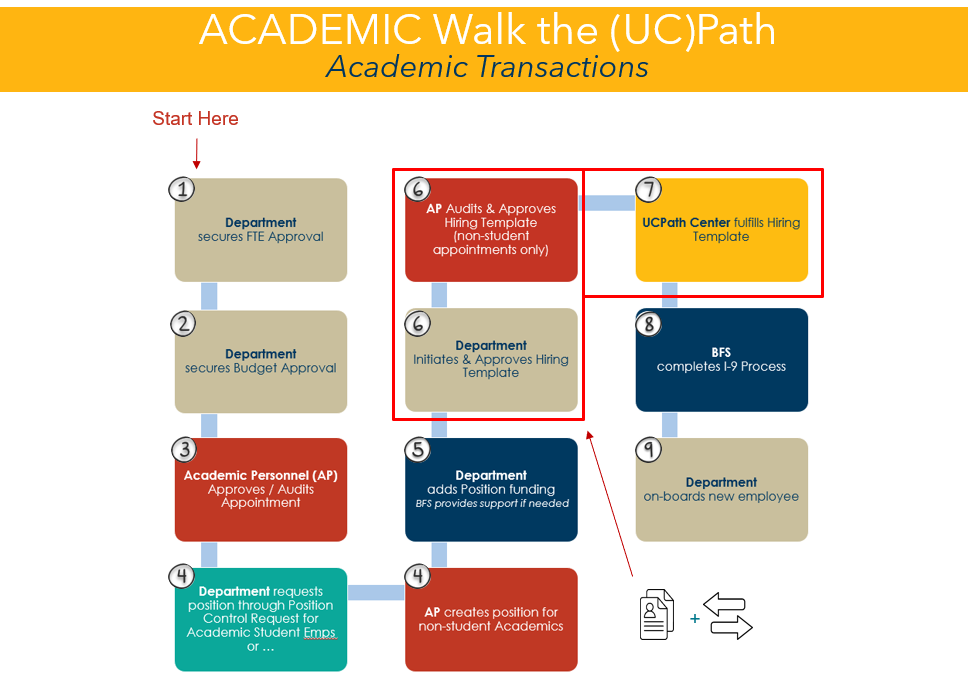
This page answers Frequently Asked Questions (FAQs) related specifically to UCPath Transactional Users, i.e., users with UCPath roles such as Initiator, Approver, etc.
Getting Started
To login to UCPath Portal use your Single Sign On (SSO) UCSBNetID. The URL is: https://ucpath.universityofcalifornia.edu
- If you can log in to the Box service at ucsb.box.com, you should be able to log in to UCPath.
- If you are unable to log into UCPath or Box, you may need to reset your UCSBNetID password. Contact the IT Services Help Desk at ucsb.service-now.com/it or call (805) 893-5000 (x5000).
- Your UCSBNetID can be managed at im.ucsb.edu/idm/manage, however, the page requires your UCPath employee ID.
- Contact your Department Security Administrator (DSA) to review your job title, role, and responsibility to determine what access you should have. Your UCPath "role" security profile might not be enabled.
- Clear browser cache/cookies first and/or use a different browser. See the Job Aid: Clear Your Web Browser's Cache.
Contact your Department Security Administrator (DSA) to review your department row-level security.
No. PSS information is not available in UCPath. PSS historical information (i.e., paycheck details, W-2 information) is stored in Data Warehouse.
Reports To information is located in position data. Check to ensure the Reports To field, in the Position Data page is populated with accurate information.
A Contingent Worker is a non-UCSB employee providing services on a non-permanent basis. They are potentially paid by a third party, and are required to sign a patent agreement, but not required to sign an Oath.
AWE is an acronym for the Approval Workflow Engine. AWE is used to route transactions for review and approval through UCPath.
For more information about approvals, access the AWE Overview and Approvals course in the UC Learning Center.
The Worklist is a page in UCPath that lists transactions that are pending your review and approval.
Your Worklist is displayed on the home page in the UCPath portal.
First, check with your supervisor or departmental Business Officer. For additional information about pay, review the information on the Help for All Employees page.
The UCPath Center is UC Santa Barbara's Benefits Administrator and is available for questions. If you are a newly hired benefits eligible employee or a current temporary/limited staff or faculty newly eligible for UC Benefits, Welcome! We ask that you watch the UCpath benefits webinars available or the pre-recorded version. (The pre-recorded version is accessible 24 hours/7 days a week.) Please be mindful of your benefits eligibility level as there are three different levels.
Please use the UCPath live online chat feature or submit your questions by logging in to UCPath and clicking on the "Ask UCPath Center" button.
Call 855-982-7284 (Monday-Friday, 8 a.m. to 6 p.m. PST) to speak with a UCPC associate.
You can locate UCPath online training from the UCSB UCPath Transactional Users pages. Access the For Transactional Users menu and choose "UCPath Job Aids, Handouts and Resources." For employee or manager self-service users, access the respective Guide for Employee Self-Service or Guide for Manager Self Service page.
Per the UCSB Kronos process, contact your departmental payroll manager and or department timekeeper.
Transaction Entry
There are several job aids that have been created to show you how to hire, terminate, or transfer employees.
See the resources on the Transactional User Job Aids page
Effective Dates indicate the date a transaction begins. For example, the effective date for a hire is the day the employee begins their job.
For more information on effective dates, see the Job Aid: Effective Dates.
Effective sequencing occurs when multiple transactions are entered on the SAME Effective Date. Effective sequencing is used to determine which transaction should occur prior to the other. For example, an employee is promoted and their pay is increased.
Campus Process
To understand the steps or how the various transactions are connected, see the Job Aid: Transaction Lifecycle. This document defines the processes and how transactions are connected.
View the step by step process: PDF Version "Walk the UCPath"

Other
Yes, we have a PPS to UCPath Terminology Crosswalk that can show you the comparison in terms between the two systems.
